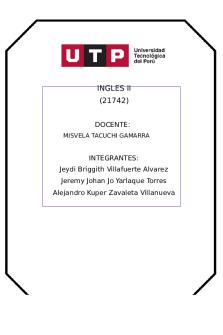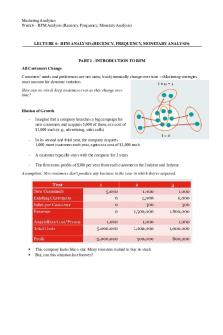Week 6 - Preliminary data analysis PDF

| Title | Week 6 - Preliminary data analysis |
|---|---|
| Author | Giulia Leone |
| Course | Marketing Research |
| Institution | City University London |
| Pages | 7 |
| File Size | 441.3 KB |
| File Type | |
| Total Downloads | 67 |
| Total Views | 155 |
Summary
Preliminary data analysis...
Description
Research in Marketing Week 6 – Preliminary Quantitative Data Analysis LECTURE 6 – PRELIMINARY QUANTITATIVE DATA ANALYSIS
PART I - QUANTITATIVE RESEARCH AND DATA ANALYSIS
Quantitative research
‘[is] a formal, objective, systematic process in which numerical data are utilized to obtain information about the world “and” a research method which is used to describe and test relationships among variables and individuals to examine cause-and-effect relationships’ (Burns and Grove, 1987).
‘emphasises quantification in the collection and analysis of data’ (Bryman and Bell, 2015).
is designed to elicit responses to pre-determined, standardised questions from a large number of respondents.
Data Preparation Converting data from a source into usablecode for data analysis“This process ensures:Data IntegrityBias (response and non-response)Inconsistent dataConvert form of data as needed
Data Preparation and Analysis Overview
Data preparation stages
Research in Marketing Week 6 – Preliminary Quantitative Data Analysis 1. 2. 3. 4.
Data validation Editing and Coding Data Entry Data Tabulation
Validation, editing and coding The purpose of validation is to determine if surveys, interviews and observations were conducted correctly and free of bias, and if data from other sources are accurate and consistent. When data collection involves trained interviewers obtaining data from respondents, the emphasis in validation most often is on interviewer errors or failure to follow instructions. If data collection involves online surveys, validation often involves checking to see if instructions were correctly followed.
1. data validation Determines whether a survey’s interviews or observations were conducted correctly and are free of fraud or bias CurbstoningCheating or falsification in the data collection process Five main areas of validation: FraudScreeningProcedureCompletenessCourtesy
2. Data editing and coding Editing is the process where the raw data are checked for mistakes made by either the interviewer or the respondent.•Asking the proper questions•Accurate recording of answers•Correct screening of respondents•Complete and accurate recording of open-ended questions
Coding involves grouping and assigning values to various responses from the survey instrument
Coding: The steps1.Generate a list of as many potential responses as possible2.Consolidate responses3.Assign a numerical value as a code4.Assign a coded value to each response
3. Data entry
Data entry refers to the tasks involved with the direct input of the coded data into some specified software package that ultimately allows the research analyst to manipulate and transform the raw data into useful information.
Research in Marketing Week 6 – Preliminary Quantitative Data Analysis Data entry follows validation, editing and coding. This step is not necessary when online data collection is used. There are several ways of entering coded data into an electronic file. With CATI and internet surveys, the data are entered simultaneously with data collection and a separate step is not required.
Manual However, other types of data collection require the data to be entered manually, which typically is done using a personal computer.
Scanning technology Scanning technology also can be used to enter data. This approach enables the computer to read alphabetic, numeric, and special character codes through a scanning device. Respondents use a number two pencil to fill in responses, which are then scanned directly into a computer file.
Online surveys Online surveys are becoming increasingly popular for completing marketing research studies. Indeed, online surveys now represent almost 60 per cent of all data collection approaches. They not only are often faster to complete but also eliminate entirely the data entry process.
4. Data tabulation Tabulation, sometimes referred to as a frequency count, is the simple process of counting the number of observations (cases) that are classified into certain categories. Two common forms of tabulation are used in marketing research projects.
One-way tabulation It categorises single variables existing in a study. In most cases, a one-way tabulation shows the number of respondents (frequency count) who gave each possible answer to each question on the questionnaire. The number of one-way tabulations is determined by the number of variables measured in the study. Cross-tabulation It simultaneously treats two or more variables in the study. It categorises the number of responses to two or more questions, thus showing the relationship between those two variables. It is most often used with nominal or ordinal scaled data.
PART II – PRELIMINARY DATA ANALYSIS
Research in Marketing Week 6 – Preliminary Quantitative Data Analysis
FREQUENCY AND DESCRIPTIVES
Descriptive StatisticsUsed to summarize and describe the data obtained from a sample of respondents“Central tendencyDispersion
Relationships between Scale Levels and Measures of Central Tendency and Dispersion
Descriptive Statistics
Research in Marketing Week 6 – Preliminary Quantitative Data Analysis
Statistics associated with frequency distribution: measures of central tendency MEAN: is the usual averageMEDIAN: is the middle numberMODE: is the number that is repeated most often
Statistics associated with frequency distribution: measures of dispersion RANGE: is the spread of the data (the difference between the largest and smallest values in the sample) (difference between mean and observed value-deviation from the mean)VARIANCE: is the mean squared deviation from the mean and is calculated as the summed squared of each observation less the mean, divided by the count of observations less one. STANDARD DEVIATION: is the square root of the variance.
Normality of Data Various types of Data1.Unobservable and observable2.Nominal –Ordinal –Interval –Ratio3.Continuous– Categorical4.Parametric-Non-parametric Data
Research in Marketing Week 6 – Preliminary Quantitative Data Analysis
The 68-95-99.7% Rule
The Normal Distribution: Skewness and Kurtosis1.Skewness. The tendency of the deviations from the mean to be larger in one direction than in the other. 2.Kurtosis is a measure of the relative peakednessor flatness of the curve defined by the frequency distribution.
Research in Marketing Week 6 – Preliminary Quantitative Data Analysis
Normality Test: Criteria1. The Histogramis roughlybell-shaped2.The meanand medianvalues must be close to each other3.TheSkewnessvalue in SPSS should be between -1 and +14.TheKurtosis value in SPSS should be between -4 and +4 Plots to help assess Normality: Histogram Normal Q-Q Plot Boxplot – useful for identifying outliers...
Similar Free PDFs

Week 6 Week 6 Week 6Week 6
- 2 Pages

DATA Analysis
- 3 Pages

Week 6 ingles Week 6
- 2 Pages

Week 6 Assignment - Week 6
- 11 Pages

Lecture 6 - week 6
- 32 Pages

Preliminary engagement
- 2 Pages

Preliminary Investigation
- 6 Pages

Data Analysis Research Paper
- 7 Pages

Graphing and data analysis
- 7 Pages

Data Analysis Instructions
- 19 Pages

Data and error analysis
- 9 Pages

Transpiration Data Analysis
- 2 Pages

DATA ANALYSIS - FINAL PAPER
- 11 Pages
Popular Institutions
- Tinajero National High School - Annex
- Politeknik Caltex Riau
- Yokohama City University
- SGT University
- University of Al-Qadisiyah
- Divine Word College of Vigan
- Techniek College Rotterdam
- Universidade de Santiago
- Universiti Teknologi MARA Cawangan Johor Kampus Pasir Gudang
- Poltekkes Kemenkes Yogyakarta
- Baguio City National High School
- Colegio san marcos
- preparatoria uno
- Centro de Bachillerato Tecnológico Industrial y de Servicios No. 107
- Dalian Maritime University
- Quang Trung Secondary School
- Colegio Tecnológico en Informática
- Corporación Regional de Educación Superior
- Grupo CEDVA
- Dar Al Uloom University
- Centro de Estudios Preuniversitarios de la Universidad Nacional de Ingeniería
- 上智大学
- Aakash International School, Nuna Majara
- San Felipe Neri Catholic School
- Kang Chiao International School - New Taipei City
- Misamis Occidental National High School
- Institución Educativa Escuela Normal Juan Ladrilleros
- Kolehiyo ng Pantukan
- Batanes State College
- Instituto Continental
- Sekolah Menengah Kejuruan Kesehatan Kaltara (Tarakan)
- Colegio de La Inmaculada Concepcion - Cebu


